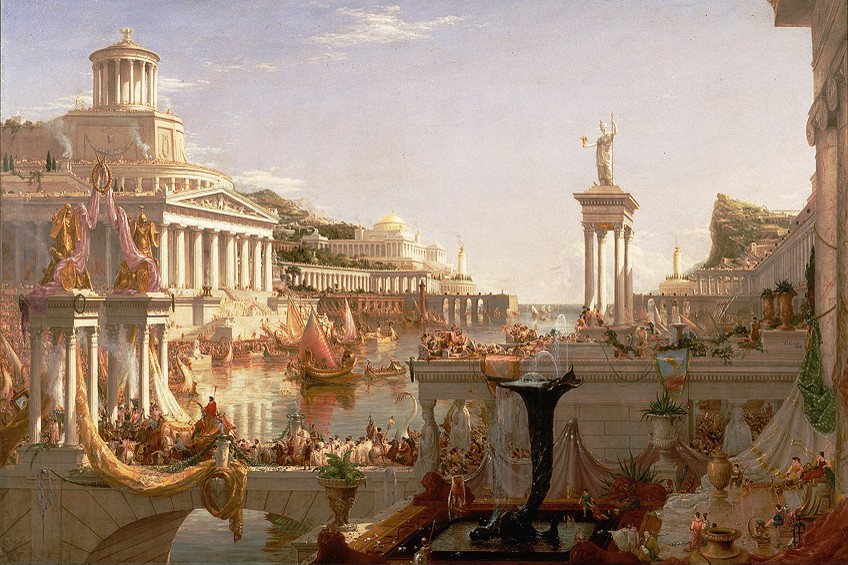“The Course of Empire” by Thomas Cole – Study the Landscape Paintings
From 1833 until 1836, a series of landscape paintings titled Course of Empire by Thomas Cole was produced. The Course of Empire paintings were important partly because they reflected typical American attitudes during that time, when many considered pastoralism as the pinnacle of human culture, believing that empire would result in excess and eventual deterioration. The set of landscape paintings comprised five pieces titled: The Arcadian or Pastoral State, The Savage State, The Consummation of Empire, Desolation, and Destruction.
The Course of Empire by Thomas Cole
The Course of Empire (1833-1836) paintings represent the rise and collapse of an imagined metropolis on the lowest end of a river valley, at its confluence with a seaside bay. The valley is clearly visible in each of the works, thanks in part to an uncommon landmark: a big rock perched atop a cliff overlooking the valley.
Some critics feel this is designed to juxtapose the planet’s immutability with humankind’s impermanence.
An Introduction to Thomas Cole
| Nationality | English |
| Date of Birth | 1 February 1801 |
| Date of Death | 11 February 1848 |
| Place of Birth | Bolton le Moors, England |
The Hudson River School, a group of artists that sought to represent the pure splendor of the American landscape, particularly that of New York State’s Hudson River Valley, is recognized as having its origins in Thomas Cole. Thomas Cole’s artwork, in many ways, embodies all of the inconsistencies of European settlement culture in America.
He was enamored with the majestic wildness of the American environment and desired to conserve it via his work.

Nevertheless, his very existence in that setting, as well as the growth of his profession, was dependent on the movements of industrialization and civilization that endangered it. His Eurocentric attention to apparently empty wildernesses that had, in reality, been inhabited for centuries appears worrisome from a contemporary point of view; where Native Americans do appear in his works, for example in Falls of the Kaaterskill (1826), it is as scenic speckles instead of defined participants in the picture.
Cole’s works typically serve as cautionary tales about the catastrophic course of human civilization, portending the destruction of the environment and the unrelenting expansion of industry, which the American mission seemed to exemplify.
A number of Thomas Cole’s writings suggest that a moment of judgment or catastrophe is about to occur. Cole was a very religious man who believed that these processes in some way violated God’s purpose.
The Course of Empire Paintings
Thomas Cole spent the wintertime of 1835 until 1836 in Catskill, focusing on The Course of Empire paintings.” During this time, Cole started to voice strong opinions on the influence of industrial growth and its terrible repercussions on the untamed grandeur of the Catskills landscapes that inspired his works.
The expansion of the railroad by “copper-hearted bandits” was especially concerning.
Thomas Cole’s father and his sponsor, Luman Reed, both died in 1836, but the year was not without joy as he would marry later that year. Thomas Cole intended for these works to be prominently displayed in the image gallery of his patron, Luman Reed’s, estate.
The Savage State (1834)
| Date Completed | 1834 |
| Medium | Oil on canvas |
| Dimensions (cm) | 100 x 161 |
| Current Location | Estate of Lumen Reed |
The first landscape painting in the series depicts the valley from the coast opposite the cliff in the early morning light on a tumultuous day. Mist and cloud envelop most of the far terrain, foreshadowing an unknown future. On the other side of the harbor, a steep hill rises, capped with a solitary isolated rock that would always be a prominent landmark to the mariner.
Because the same location is depicted in each image of the series, this rock identifies it, even when the observer’s position moves among the images.

The pursuit being the most distinctive employment of savage life, we see a man dressed in hides in chase of a deer, which has been struck by an arrow and is dashing down a river. On the cliffs in the center ground, barbarians with dogs are pursuing deer. Numerous canoes can be observed on the waters below, and on the point beyond, there are numerous huts and a multitude of people dancing around a fire. The initial rudiments of civilization are seen in this image. Men gather together for mutual help in the pursuit, and so forth.
The utilitarian arts have begun with the creation of boats, shelters, and weapons. Two of the high arts, poetry, and music, are said to have originated in the singing that generally accompanied wild dances. The empire is established, albeit to a limited extent, over the ocean, earth, and animal kingdom.
Spring is the season portrayed. Native American existence is shown visually. This picture represents the natural world in its perfect form. It is a wholesome world that has not been tainted by humans.
The Arcadian or Pastoral State (1834)
| Date Completed | 1834 |
| Medium | Oil on canvas |
| Dimensions (cm) | 100 x 161 |
| Current Location | Estate of Lumen Reed |
The skies have brightened in the second landscape painting, and we are in the early dawn of a spring or summer day. The perspective has relocated farther down the river, with the cliff with the rock now on the left side of the picture, and a branched peak beyond it visible in the distance. Many parts of the forest have been converted to agricultural land and farmland, with apparent plowed fields and gardens.
Various activities are taken on in the distance, including plowing, boat construction, sheep grazing, and dance; in the front, an elderly man draws what appears to be a mathematical puzzle with a stick.
A megalithic temple has been erected on a hillside on the river’s nearer bank, and smoke is rising from it. The paintings depict a romanticized pre-urban Archaic Greece. This particular landscape painting of the set depicts humans at peace with nature. The ecosystem has changed, but not to the point that it or its people are in danger. Nonetheless, the building of the vessel and the anxious mother watching as her youngster draws a soldier foretell the emergence of imperial aspirations. This artwork, according to Thomas Cole, shows the scene after many years had gone.

The steady improvement of civilization has resulted in a change in its appearance. The “untracked and harsh” have been tamed and controlled. Shepherds are maintaining their herds, the plowman is upturning the earth with his cattle, and Business starts to spread her wings. This artwork, according to Cole, shows the scene after many years had gone. The steady improvement of civilization has resulted in a change in its appearance. The “untracked and harsh” have been tamed and controlled.
Shepherds are maintaining their herds, the plowman is upturning the earth with his cattle, and Business starts to spread her wings. A hamlet is expanding along the beach, and smoke of sacrifices is now rising from the temple.
A woman with a distaff is ready to cross a rough stone on the right side of the image. A youngster appears to be sketching a man with a blade on the stone, while a soldier can be seen approaching the path. Several villagers may be observed under the woods, far beyond the female figures; some are frolicking, while another plays the pipe.
Agriculture, business, and religion are all represented in this diagram. The older man who analyzes the mathematical figures, the woman with the distaff, and the early temple on the hill all show that the utilitarian arts, visual arts, and technologies have advanced significantly. The image is meant to be seen in the early summer, a few hours after daybreak.
The Consummation of Empire (1836)
| Date Completed | 1836 |
| Medium | Oil on canvas |
| Dimensions (cm) | 100 x 161 |
| Current Location | Estate of Lumen Reed |
The third landscape painting switches the perspective to the other shore, near the location of the opening in the first picture. Both sides of the valley area are now adorned with colonnaded marble constructions with stairs that go down into the water. The megalithic temple appears to have been turned into a massive domed building that towers over the riverbank. The river’s mouth is defended by two golden statues, and ships sail out to sea.
An exquisite fountain spills in the foreground. The painting’s appearance evokes the glory days of Ancient Rome.
The decadence visible in every feature of this metropolis foreshadows this strong civilization’s impending doom. Based on Thomas Cole’s description of the work, we’re supposed to believe that other eras have gone and the rough hamlet has evolved into a glorious city. The spectator has now traversed the bay, and the viewable area extends along both sides of it. It has been transformed into a large harbor, with two golden statues guarding the entrance to the sea. Piles of building rise from the ocean on either hand – temples, domes, and colonnades.

It is a joyous occasion. A triumphant procession crosses the bridge in the foreground. The victor, swathed in purple, rides in a vehicle driven by an elephant, flanked by captives on foot and a large train of soldiers, legislators, and so on — portraits and gold valuables are presented before him. He is going to pass underneath the triumphal arch, which is strewn with flowers. Drapery festoons dangle from the grouped columns. In the sun, golden awards gleam, and plumes rise from silver censers. The harbor is bustling with ships, including battle galleys and silken sails.
The haze of incense and the altar rises before the temple to the left, and a swarm of white-robed priests gathers on the marble stairs. The figure of Minerva, holding a triumph in her hand, rises above the Caryatides structure, beside which is a group with horns, cymbals, and other instruments.
A royal personage watching the parade on the right, beside a bronze waterfall and in the shadow of tall buildings, is flanked by her children, entourage, and guard. The pinnacle of human splendor is shown in this scenario. The architecture, ornate decorations, and so on demonstrate that riches, power, wisdom, and taste have collaborated to attain the pinnacle of human accomplishment and dominion.
As the triumphant procession suggests, man has conquered man, and countries have been enslaved. This picture is depicted as being about midday in early Autumn.
Destruction (1836)
| Date Completed | 1836 |
| Medium | Oil on canvas |
| Dimensions (cm) | 100 x 161 |
| Current Location | Estate of Lumen Reed |
This landscape painting has nearly the same viewpoint as the third, but the painter has pulled back a little bit to allow for a more expansive image of the activity and has gone almost to the middle of the river. The scenario is the sacking and destruction of the city amid a distant tempest.
A squadron of enemy warriors appears to have overrun the city’s fortifications, floated up the river, and is currently ransacking the city, slaughtering its citizens, and pillaging women.
The bridge that the victorious parade had crossed has collapsed, and a temporary footbridge is straining under the pressure of troops and migrants. Columns are shattered, and fire erupts from the upper levels of a riverside castle. A statue of some legendary hero stands headless in the front, still marching forth into the unknown future. In the fading light of early evening, the deceased lie where they landed, in pools and on monuments designed to commemorate the civilization’s prosperity.

On the other side, a feature in the bottom right of The Consummation of Empire depicts two youngsters, perhaps siblings, fighting, one dressed in green and the other in red—the colors of the opposing forces’ banners in “Destruction,” which could represent a foretold civil war. The youngsters, now men, are depicted, with one eventually triumphing over the other, but clearly contemplating the high price paid.
The red and green flags are on opposite sides of the river in the artwork, with the green flags largely on the temples side and the red flags mostly on the side of the palace, possibly representing the ongoing battle between tradition and modernity. This artwork of the series depicts the Vicious State, according to Thomas Cole’s descriptions. Ages may have gone since the scene of glory, yet nations’ declines are often faster than their rises. Luxury has been diminished and degraded.
A deadly foe has infiltrated the city. A terrible storm is raging. Walls and columns have been demolished. Monuments and palaces are engulfed in flames.
An arch of the bridge, over which the triumphant procession was crossing in the previous scene, has been smashed down, and the shattered pillars, the wreckage of war machines, and the improvised bridge that has been put across show that this was a battleground. Now there is a mixed crowd clashing on the tiny bridge, and their anxiety heightens the battle.

Horses and men are thrown into the surging waves beneath; war galleys clash: one is on fire, and another is plunging beneath the bow of the ship of a superior adversary. The competing vessels are being smashed by the raging waves in the furthest reaches of the port, and others are on fire. The fighting is ferocious along the battlements, among the shattered Caryatides, and the fighters struggle among the flames and blaze of collapsed edifices.
There are numerous dead and injured people in the foreground, and some of their corpses have fallen into the bowl of a fountain, tingeing the stream with their blood. A woman is seen being dragged by the hair down the steps that make up the pedestal of a desecrated gigantic statue, whose severed head is on the ground below, while a youthful woman is seen trying to escape from a trooper’s rapacious grasp by springing over the battlement.
A woman is also seen sitting in silent desperation over the lifeless corpse of her son. The city is taken over and sacked by a vicious and destructive adversary. Perhaps there is no need to describe this image; its components are bloodshed and ruin.
Desolation (1836)
| Date Completed | 1836 |
| Medium | Oil on canvas |
| Dimensions (cm) | 100 x 161 |
| Current Location | Estate of Lumen Reed |
Number five of the series’ landscape paintings demonstrates the outcomes many years afterward. In the vivid light of a waning day, the city’s ruins stand out. The area has started to transform back into a wilderness, and no signs of human habitation can be seen. However, the ruins of human architecture can be seen emerging from behind a cover of trees, ivy, and other vegetation.
The pillars of the temple and the bridge’s collapsed arches are still discernible, and one massive column that once supported a bridge now serves as a bird nesting site.
This bleak image portrays what all civilizations may look like following their destruction. In this grim hypothetical scenario, humanity has annihilated itself. Based on Thomas Cole’s descriptions, this represents desolation. The moon is rising in the dusk sky over the water, close to where the sun rose in the first image, as the sun has just set. As the sun sets, the shades of dusk creep over the broken and ivy-covered ruins of that once-proud metropolis.

A heron has made her nest atop a lone column that stands close to the foreground and is illuminated by the setting light. The triumphal arch and the temple may still be discernible among the remains. However, despite the demise of man and his creations, the sharp promontory with its protected rock continues to rise against the sky unaffected and unmodified. Man’s creations have been destroyed by violence and the passage of time and nature is once more resolving into art.
Thomas Cole’s pessimism is evident in this cycle, which is sometimes seen as a critique of Andrew Jackson as well as the Democratic Party.
Take Consummation’s central military hero, for example. But some Democrats held a different view of how empires developed. They saw an ascending trajectory rather than a spiral or loop. For instance, in response to Cole, Democratic Supreme Court Justice asserted that there wouldn’t be any devastation in the US.
“The Course of Empire” by Thomas Cole created what he called a “higher type of landscape,” one that was infused with historical references, moral lessons, and what the artist believed to be fundamental truths about people and their enduring connection to nature. Cole’s writing was greatly affected by a vacation to Europe. He first encountered ancient civilizations’ remains there, relics of a history that was absent from America. The elite’s rising interest in ancient history is also reflected in “The Course of Empire” paintings.
Frequently Asked Questions
What Was The Course of Empire by Thomas Cole About?
The Course of Empire paintings, a set of five canvases by Thomas Cole that depict the progression of human civilization from the so-called savage wilderness to high civilization and its inescapable demise, took the artist three years to complete. America experienced a period of optimism in the 1830s. The first signs of industrialization appeared with the completion of the Erie Canal and the first US locomotive, Tom Thumb, started operating. The romantic glorification of the pastoral life was on display in The Course of Empire by Thomas Cole, which served as a caution against the arrogance of empire construction.
Who Was Thomas Cole?
In many respects, Thomas Cole’s work epitomizes all the contradictions of European settlement culture in America. He was charmed with the beautiful wildness of the American environment and wanted to protect it via his work, yet his entire life in that environment, as well as the development of his profession, depended on the industrialization and civilizational trends that threatened it. The Hudson River School, a group of artists that sought to represent the pure splendor of the American landscape, particularly that of New York State’s Hudson River Valley, is recognized as having its origins in Thomas Cole. Thomas Cole’s works typically serve as cautionary tales about the catastrophic course of human civilization, portending the destruction of the environment and the unrelenting expansion of industry, which the American mission seemed to exemplify.
Alicia du Plessis is a multidisciplinary writer. She completed her Bachelor of Arts degree, majoring in Art History and Classical Civilization, as well as two Honors, namely, in Art History and Education and Development, at the University of KwaZulu-Natal, South Africa. For her main Honors project in Art History, she explored perceptions of the San Bushmen’s identity and the concept of the “Other”. She has also looked at the use of photography in art and how it has been used to portray people’s lives.
Alicia’s other areas of interest in Art History include the process of writing about Art History and how to analyze paintings. Some of her favorite art movements include Impressionism and German Expressionism. She is yet to complete her Masters in Art History (she would like to do this abroad in Europe) having given it some time to first develop more professional experience with the interest to one day lecture it too.
Alicia has been working for artincontext.com since 2021 as an author and art history expert. She has specialized in painting analysis and is covering most of our painting analysis.
Learn more about Alicia du Plessis and the Art in Context Team.
Cite this Article
Alicia, du Plessis, ““The Course of Empire” by Thomas Cole – Study the Landscape Paintings.” Art in Context. July 13, 2022. URL: https://artincontext.org/the-course-of-empire-by-thomas-cole/
du Plessis, A. (2022, 13 July). “The Course of Empire” by Thomas Cole – Study the Landscape Paintings. Art in Context. https://artincontext.org/the-course-of-empire-by-thomas-cole/
du Plessis, Alicia. ““The Course of Empire” by Thomas Cole – Study the Landscape Paintings.” Art in Context, July 13, 2022. https://artincontext.org/the-course-of-empire-by-thomas-cole/.











